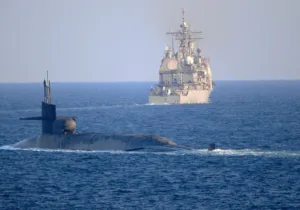The Vatican issued an appeal to several countries—including the United States—to ban cluster bombs. In the statement, Archbishop Ivan Jurkovič, the Vatican’s Permanent Observer to the United Nations in Geneva, says countries that haven’t signed the ban on cluster bombs should consider “joining the global efforts and our common goal in building together a more humane, more secure and more cooperative world,” adding, “We owe this to the too many victims of the past and to prevent further victims.”
Here is what you should know about cluster bombs:
1. Cluster munitions (colloquially referred to as cluster bombs) are air-dropped or ground-launched weapons that release a number of smaller sub-munitions intended to kill enemy personnel or destroy vehicles. They can be delivered by aircraft or from ground systems such as artillery, rockets, and missiles.
2. Military forces value cluster munitions because they can create a larger area of destruction within a bomb’s impact area. This allows fewer weapons systems to deliver fewer munitions to attack multiple targets. Cluster munitions are also considered an “economy of force” weapon since they permit smaller forces to engage a larger adversary.
3. Cluster bombs were first used in World War II when Soviet forces use air-dropped cluster munitions against German tanks. German aircraft also dropped over 1,000 SD2 “butterfly bombs” in an attack on the UK’s port of Grimsby. Since their development, cluster munitions have been used in at least 21 countries by at least 13 states.
4. Since their adoption in the early 1940s, over 210 different types of cluster munitions, including projectiles, bombs, rockets, and missiles, have been stockpiled in 80 countries and created by 33 nations: Argentina, Belgium, Brazil, Bulgaria, Canada, Chile, China, Democratic People’s Republic of Korea, Egypt, France, Germany, Greece, India, Iran, Iraq, Israel, Italy, Japan, Pakistan, Poland, Republic of Korea, Romania, Russian Federation, Serbia and Montenegro, Singapore, Slovakia, South Africa, Spain, Sweden, Switzerland, Turkey, the United Kingdom, and the United States.
5. The United States used cluster munitions extensively in the conflict in South-East Asia during the 1960s and 1970s and during the Gulf War in 1991. From 2001 through 2002, U.S. forces also dropped 1,228 cluster bombs containing 248,056 sub-munitions in Afghanistan and an estimated 1.8 million to 2 million sub-munitions during the first three weeks of combat in Iraq in 2003. (The U.S. military has not used them since 2003.)
6. A common criticism of cluster munitions is that they (1) disperse large numbers of sub-munitions imprecisely over an extended area, (2) frequently resulting in post-attack unexploded ordnance (UXO) that is (3) difficult to detect and that can remain an explosive hazard for decades. “While all types of explosive ordnance fail to function at some rate, the failure rates for cluster munitions are distinct as they are so high,” says Mark Hiznay, “they are increasingly documented, and are now accounted for in the planning of military operations.”
7. According to Cluster Munition Monitor 2017, at least 21,200 cluster munition casualties—almost all of which were civilians—have been confirmed globally since the 1990s. About 17,291 came from unexploded sub-munitions, and about 3,983 from strikes. However, estimates for a global total range from 58,000 to 85,000.
8. Unexploded cluster munitions have been a significant problem in Laos. Throughout the Second Indochina War (1964-1973), over 270 million cluster munitions were dropped on the country, of which an estimated 80 million malfunctioned and remained live and buried in the Lao landscape. From 1964 to 2008, there were more than 8,000 victims of cluster munitions UXO. About 25 percent of these victims were children.
9. On May 30, 2008, at the Dublin Diplomatic Conference on Cluster Munitions, 107 states adopted a comprehensive treaty banning cluster munitions, the Convention on Cluster Munitions (CCM). The CCM is a legally binding international treaty that prohibits the use, production, stockpiling, and transfer of cluster munitions and requires clearance of remnants and destruction of stocks. According to the Arms Control Association, the treaty requires states to provide assistance to survivors and their communities and builds on existing international human rights and humanitarian law. The treaty requires states to destroy existing stockpiles within eight years and to clear contaminated land within 10 years. A total of 102 states have ratified the CCM as of August 1, 2017, and 119 states have signed it. The United States, China, Russia, India, Israel, Pakistan, Brazil, and several other countries have refused to sign the treaty.
10. The U.S. policy on cluster munitions is guided by a June 2008 U.S. Department of Defense directive requiring that any use of cluster munitions before 2018 that results in a one percent or higher UXO rate—which includes all but a tiny fraction of the US arsenal—must be approved by a “Combatant Commander,” a four-star general or admiral. After 2018, the United States will no longer use cluster munitions that result in more than one percent UXO. This policy recognizes the need to minimize harm to civilians and infrastructure but also reaffirms that “cluster munitions are legitimate weapons with clear military utility.”
—
Joe Carter is an adjunct professor of journalism at Patrick Henry College, an editor for several organizations, and the author of the NIV Lifehacks Bible.
Photo Credit: A B-1B Lancer unleashes cluster munitions. U.S. Air Force photo.







 Live in the DC area? Sign-up for Providence's in-person events list!
Live in the DC area? Sign-up for Providence's in-person events list!